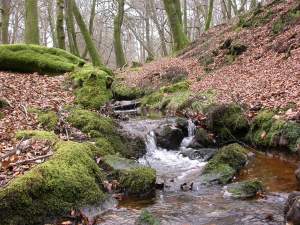Ashdown Forest is the largest remaining bit of heath in the south east of England, and is the remnants of a medieval hunting ground (hence ‘forest’).[1] Within it are numerous deeply-incised streams, locally called ghylls, which are fabulous habitats for species that are otherwise rare in the region.
Today, Tim Rayner and I explored one such ghyll south of Ashdown Park Hotel, primarily in search of the moss Hyocomium armoricum, which Tim is currently researching. It is usually a western, oceanic species, though the High Weald hosts several populations.
The stream is quite fast-flowing at times, and often deeper than our boots so we had to be alert else we’d have got very wet feet. And you couldn’t just look down all the time, either; much of the area has now been encroached quite badly with Rhododendron, so there was also the risk of bashing your head on overhanging branches, or simply having to squeeze and thrash your way through the thicket. It’s no wonder it’s an area that has been little recorded.
Jumping off the footpath and into the stream we quickly spotted Platyhypnidium riparioides and lots of Chiloscyphus polyanthos before heading downstream. It wasn’t long before we were ducking under or clambering over fallen trees and sliding down steep muddy banks, and then the Hyocomium came. There were quite a few large clusters of it, especially where the stream was quite rapid with relatively steep (though not necessarily tall) sides.
A few other things caught our attention too. This dog lichen was on a Hypnum-covered tree than had fallen across the stream. My lichen skills aren’t brilliant, but since it had simple unbranched rhizines, it may well be Peltigera praetextata. A neighbouring beech had some nice fruiting Cryphaea heteromalla too.
At a corner of the stream where some effluent seemed to be flowing in was some Conocephalum conicum bearing antheriophores, which produce the antheridia and hence the sperm.
At the same spot, and pretty much under the effluent pipe was more Hyocomium, clearly tolerating some obviously sub-optimal conditions.
Moving on and battling our way through ever-denser Rhododendron we came across a tall shady bank, sporting what turned out to be a copious colony of the liverwort Bazzania trilobata. This was certainly the find of the day. Like Hyocomium it has an especially western distribution but has even fewer sites in the south east.
Tom Ottley, the county recorder, supplied the local map, which further illustrates its scarcity in Sussex (today’s find marked in blue). Its main sites are on the sandrocks at Eridge and Wakehurst.
But then back to the Hyocomium and we finished with exploring a small tributary that had the moss pretty much all along its length. There are some bigger populations in the Weald than previously thought.
[1] “Royal Forest.” Wikipedia. Wikimedia Foundation, n.d. Web. 17 Feb. 2016. <https://en.wikipedia.org/wiki/Royal_forest>.
























